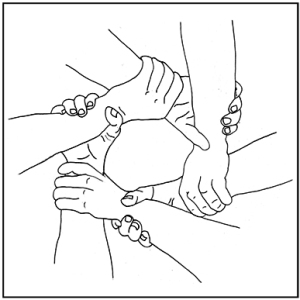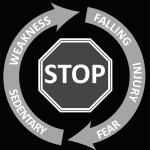The onset of weakness in the balance system can be subtle and therefore easy to miss in the early stages. The following information may help to determine if you are at risk for falling. Trust your intuition. If you feel that your balance system is not functioning properly, you are most likely correct.

Balance arises from a system of interlocking elements.
DO NOT ACCEPT FALLING AS AN INEVITABLE RESULT OF AGING. Age is a risk factor for falling that can be offset by understanding the balance system and the factors that influence balance and movement. By increasing physical and mental fitness levels, modifying behaviors, and identifying environmental factors that increase the risk of falling, the chances of falling can be reduced.
Balance is much more than just common sense! Balance is a system. Awareness is only one component among several interlocking pieces.
What is Normal Balance?
It is normal to experience minor balance loss. It happens all of the time. When the balance system is working properly, we are able to quickly compensate for changes in balance. Watch people moving in a shopping mall. You will see occasional disruptions in balance, but you will not observe people falling. Under normal circumstances, falling is a rare event. The balance system is very reliable. That is why feeling unstable, falling, or frequent balance loss are clear indicators that the system is not functioning normally and are cause for concern.
Risk Factors:

Stop the Fear Cycle: low activity levels increase muscular weakness which increases fall risk. Consequently, fear of falling increases and the willingness to move decreases even more.
- The most common risk factor associated with balance impairment is a sedentary lifestyle leading to muscular weakness, especially in the hips and legs. Have you been physically inactive (laying down or sitting for the majority of your waking hours) for two weeks or more? There could be many reasons for reduced activity such as long work days spent sitting at a desk, recovery from injury or illness, inflammatory flareups, mourning, depression, or lifestyle choices.
- Joint replacements may alter sensory perception in the extremities and increase the risk of falling.
- Distractions that alter concentration such as chronic pain, poor sleep patterns, fear of falling, or other forms of emotional stress can decrease awareness.
- Use of alcohol or other drugs affecting concentration and equilibrium
- Walking too fast or sudden impulsive movements such as an abrupt turn
- Environmental hazards such as clutter, uneven walkways, lack of handrails
Signs of Impaired Balance:
- Difficulty rising from a seated position
- A pattern of falls – more than one fall in a year is sufficient reason to be concerned – especially if the reason for the fall is unclear
- Changes in walking patterns
- Dragging the feet rather than lifting when walking (shuffling)
- Frequent tripping or stumbling for no apparent reason
- Trouble walking while talking
- Constantly looking down at the feet when walking especially with bent posture
- Difficultly negotiating stairs or curbs
- Avoiding activities or locations because of anxiety about falling
- Emotional irritability under stressful balance conditions such as walking on grass or negotiating a flight of stairs while talking to someone
- Tipping backwards, forward, or sideways for no apparent reason
- Feeling light headed (a feeling of instability but no spinning sensation)
- Feeling dizzy (spinning sensation)
- Numbness in the feet
- Tripping when wearing flip flops, bedroom slippers or high heels
Next Steps:
- Determine the Cause
- Comprehensive balance assessment (see note below)
- Evaluation of possible causes by a health professional
- Eye exam – changes in vision can have a significant impact on balance control
- Take corrective action
- Medical treatment
- Physical Therapy if indicated
- Balance and Mobility training

- Other forms of fitness training such as walking, Tai Chi, resistance training, Yoga, Pilates, dance, or water aerobics. In order to improve balance, physical activity must involve a variety of movements in all three planes of motion.
NOTE: Be wary of quick balance assessments at health fairs and other functions where you are asked to perform only a couple of balance tasks such as standing on one leg, or walking a straight line. Be suspicious if you are urged to sign up for a fee-based balanced class after only a cursory assessment. A comprehensive balance assessment involves evaluating performance of a variety of tasks that test strength, flexibility, cognitive function, reflexes, and range of motion and an interview regarding your health issues, movement patterns and balance concerns. Many people experience difficulty controlling balance under specific conditions. It takes a variety of assessment techniques to sort it out and determine a course of corrective action.

Leave a Reply